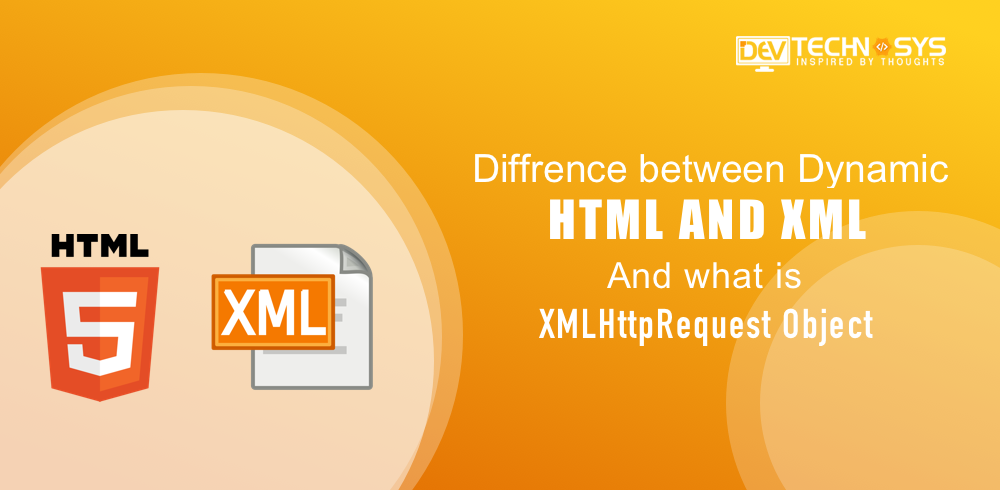DHTML, in general, is used by developers to create attractive and reliable animated web pages in real-time which are also known as dynamic web pages. In Backend development, whenever the web pages are accessed, the code present between them is quickly analyzed on the webserver and the outcome of such instance is sent to the web browser of the client. XML, on the other hand, is a text-based format having robust support with its Unicode. The biggest significant difference between both of them is that the former one uses position information and later uses text description for the web page.
DHTML represents a unique way of controlling multiple HTML standard codes. HTML alludes to the markup language that is mostly used to create non-interactive or non-animated websites on web pages. XML in the same instance is a markup language which is capable of mirroring the syntax of HTML. The dynamic HTML involves the combination of HTML codes and scripting languages like JavaScript through which developers can easily create interactive or animation based websites.
XML and DHTML in Web application development are built for different purposes
DHTML can be said as an extension of dynamic HTML which is in itself a unique way of managing and organizing the basic HTML codes and other commands. It refers to the collection of technology which is mostly used to develop interactive or animated web application development purposes. It offers more control to the developers over the elements involving HTML and through this one can easily incorporate the client-side scripting format and languages like JavaScript, CSS, document object model and so on in the web pages.
Through the DHTML format developers in Custom website development projects can easily enable them to change at any specific time without having the requirement to return to the server at first. It also allows the script languages to change the visual of the webpage along with its function right after the page has been loaded completely during the process.
Through the DHTML format, developers can add effects to the web pages which otherwise are extremely hard to implement. DHTML can be set as a cover that embodies client-side services corresponding to the websites. Fundamentally, it involves the functioning of the document object model tree for any HTML page using a browser supported script and it is entirely based upon the user’s interaction.
XML is an acronym for extensible markup language developed specifically by W3C for Custom website development instances. It refers to a well-defined set of codes for encoding the documents in a human-readable as well as a machine-readable format. It also enables the designers for creating their customized tag, transmission, data interpretation, and definition between the organizations as well as applications. XML as a text-based format offers strong support by the Unicode of the languages.
It entirely focuses on simplicity and usability across the internet and is widely used for the presentation of multiple arbitrary data structures. In the Website development company, the developers often use API during the XML data processing aiding the overall definition of languages based on the framework. The XML format has also structured the fundamentals for various other formats including XHTML, Atom, SOAP and many more. The document formats based on XML are also defaults for many other tools like Microsoft Office, LibreOffice, OpenOffice.org and so on. The outline of the differences between XML and HTML is-
- The DHTML format is used for positioning the information available in the web Front end development and describing the web page information
- DHTML can be said as the JavaScript action with HTML in which XML represents a universal way of transmission in the information other than the markup language.
- The DHTML format is also used to visualize the dynamic web pages on the other hand XML represents a markup language which is specially designed for the implementation of web documents.
- The XML format is also a representation of an extensible markup language that was initially developed for Full stack development services in order to retain scalability and flexibility. It is also capable of securing the power of HTML format along with reducing major complex issues.
Understanding the XMLHttpRequest Object
The XMLHttpRequest is popularly known as Ajax which makes every segment of frontend and Backend development significant. Basically it is an ActiveX object which means that its utility is restricted for Microsoft intranets and it is not really reliable for the website. Luckily with the implementation of JavaScript by Mozilla team has supported the cores providing Mozilla based web browser. Basically the XMLHttpRequest in web development services is used to support the fundamental scripts and old browsers. Its basic request is basically used for data exchange over the server and it is highly functional for the Web Front end development because of the below-mentioned reasons.
- It helps the developers to update any web page without having the requirement to reload each of them.
- Through this, a request can be generated from the server even after the page has reloaded.
- The developer community can receive the data from any server once the page has been reloaded.
- In the background, the developer can manage the transmission of data from server to server.
The object methods of XMLHttpRequest are mentioned below-
- Abort()- It means to cancel the recent requests.
- getAllResponseHeaders ()- It means to return the header information.
- getResponseHeader()- It means to return the specific header information.
- Open (method, pswd, async)- It specifies the request type, URL, in case the request is handled asynchronously then other attributes of the request method are also considered.
- Send (string)- It means to send the request out of the server. The string is used to post the requests.
- setRequestHeader()- It means to add any label or value pair that has to be sent.
Object Properties of XMLHttpRequest
XMLHttpRequest refers to the built-in object instances that allow the developers to quickly generate HTTP requests followed by JavaScript. In spite of having the XML behind the name, it is not limited to operate on any data type or any format. The developers can instantly upload download multiple files across it along with tracking the progress made.
Read the blog- Why to Choose AngularJS Framework for Front end Development
The XMLHttpRequest is used for the objects to easily interact across the server and the developer can retrieve data through any URL without having the requirement to refresh or load the page. This enables the website or web page to automatically update the initial part of it without interrupting the user. XMLHttpRequest has a crucial role to play in the Ajax programming services for the Website development company.
- on ready state-change-It stores the function or its name that has to be announced automatically every time the property changes from the ready state.
- Ready state- This property holds the status of XMLHttpRequest and it significantly changes between 0 to 4.
- Response text- It returns the response data in the form of string.
- Response XML- It returns the response data in the form of the XML string.
- Status- It instantly returns the status number.
- Status text– It returns the text.
Following the mode of operation, it has two possible ways that is- synchronous and asynchronous.
XML represents a complement of DHTML
The XML language was initially developed to elaborate on the idea and focalizes the data representation. It is also capable of displaying the data looks on the other hand example is entirely focused on describing the data. XML is highly extensible whereas the tags which are used for the documents in DHTML are predefined. In future events, XML markup language will remain authentic to describe the web data structure for multiple Full stack development services and DHTML will be secured for displaying the data.
XML can be used to perform following-
- Storing the data individually from the DHTML
- Using the data inside other HTML documents or files.
- To use as a format in order to conduct the exchange of information.
- To store the data in a database or other folders.
DHTML significantly allow other developers to conduct below-mentioned functioning into the web development services-
- Animating the text or images in the document files and independently transforming every element from the initial point to the final point. They can also determine the path chosen by data or elements or the path chosen by the user.
- The developers can easily embody ticker which is capable of automatically refreshing the content with its updates or data news.
- The developers can utilize the basic form to capture various inputs for the process and verify the data request without having the requirement to actually send it back to the server.
- The user can easily utilize rollover buttons or well-defined dropdown menus.
- DHTML is capable of monitoring the pages and other websites to load.
Conclusion
The DHTML and XML languages are mostly related to each other out of which HTML is basically used for data representation and the major goal behind XML is to store or pass the data. The predefined markup language is HTML and standard markup language is XML which is used to define various other languages.






























